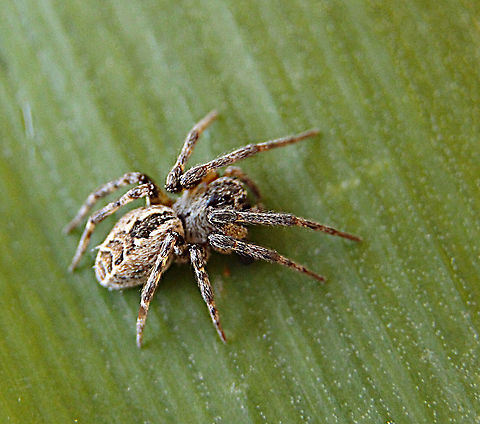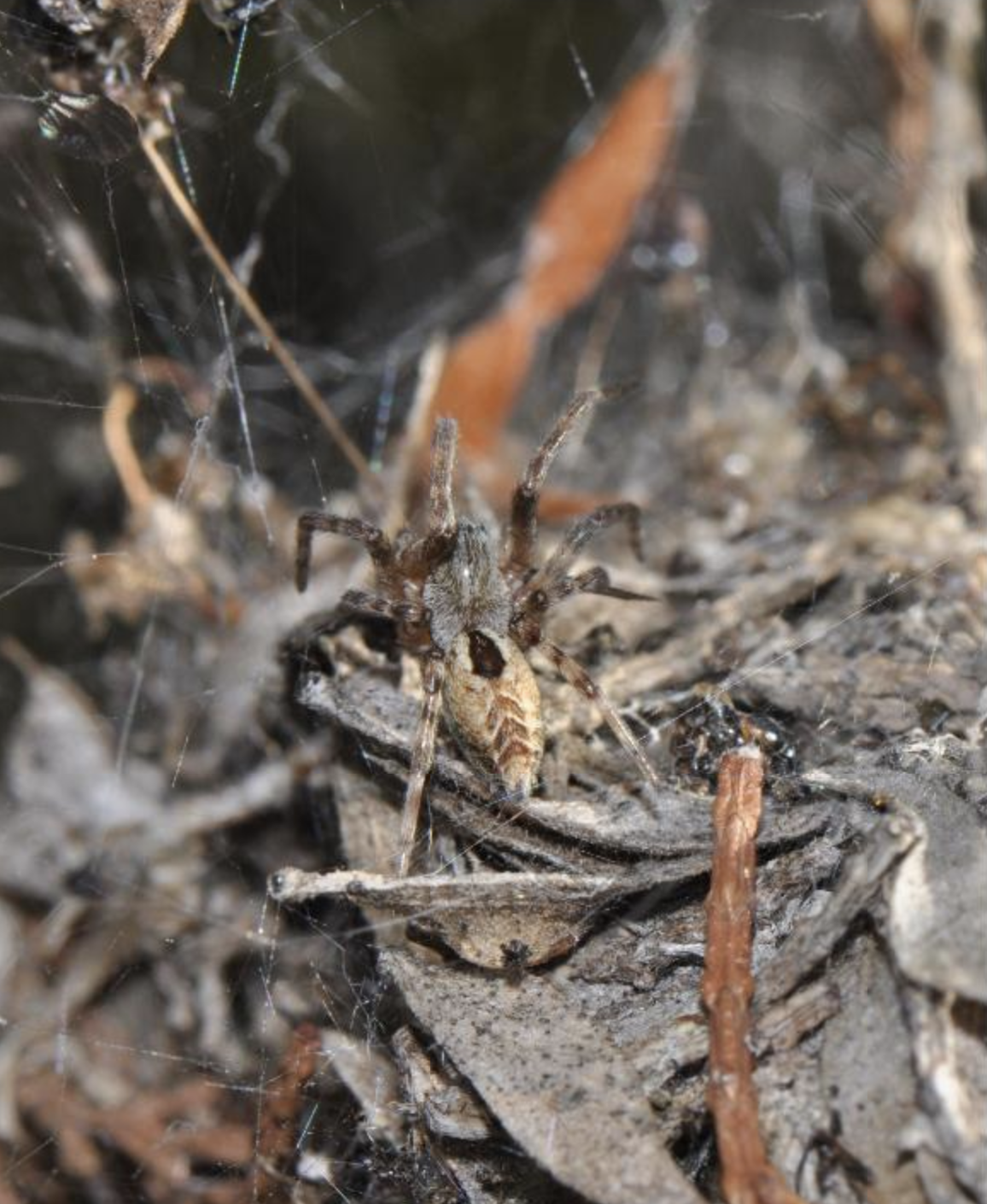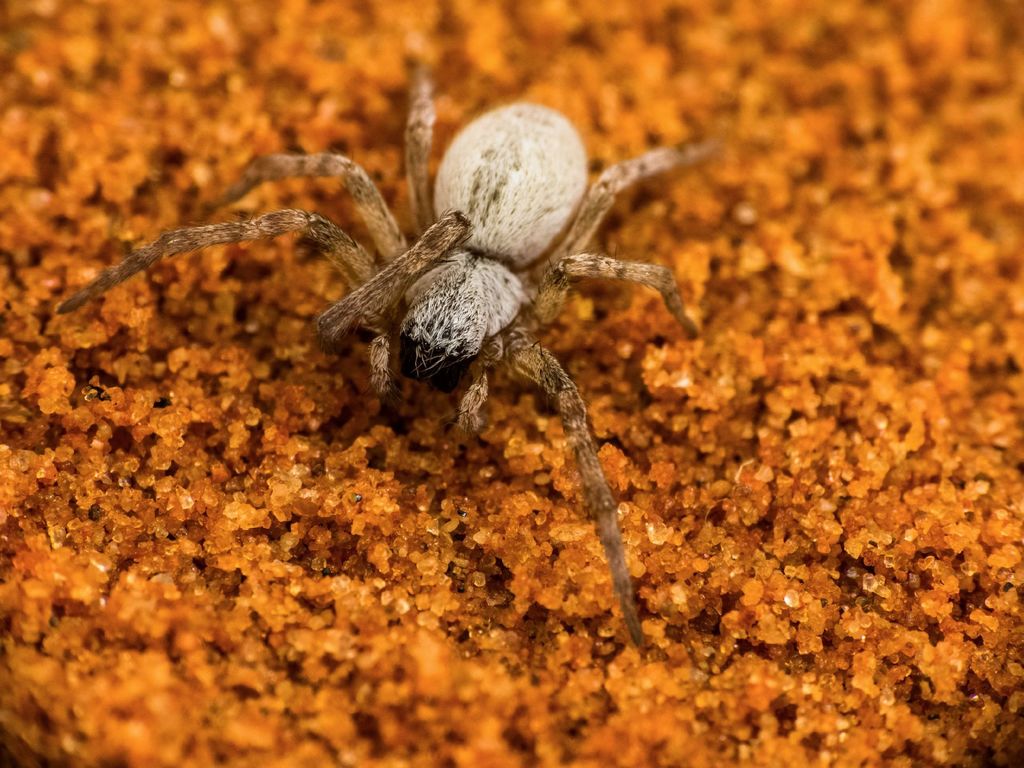
Lace-web Spiders – Desidae
Most of the spiders in this family are builders of woolly ‘lace-webs’ that are common on houses, fences and in trees in nature. During the day they tend to be hidden away inside a funnel-like retreat and rush out onto the web when prey is detected. At night they can often be seen in the doorway to their retreats or on the web itself. This group includes on of Australia’s most common species, the Black House Spider (Badumna insignis). It also includes a social spider (Phyrganoporus candidus) which lives in groups and creates communal woolly nests within foliage in forests.
While bites from Black House Spiders (Badumna insignis) have been known to cause headaches and nausea, usually they cause little more than acute localised pain and swelling. Due to their appearance and funnel-like web, they are often mistaken for Australian Funnel-webs, which they are not related to.
The Leaf-curling Spiders (genus Phonognatha) are day-active orb weaving spiders that protect themselves from predators by sitting inside a silk seamed, curled leaf.
Identification
Mainly identified by their curled-leaf retreats in which they hide with only their legs exposed, Leaf-curling Spiders are fat, oval-shaped spiders with red-brown legs and body and a cream coloured pattern on their backs.

Other behaviours and adaptations
Leaf-curling Spiders hoist a leaf from the ground and, using silk threads, curl it to form a protective cylinder, silked shut at the top and open at the hub.. They then sit in this cylinder with only their legs showing, feeling for the vibrations of a captured insect. The curled leaf protects them from birds and parasitic wasps. Sometimes other objects, such as snail shells (which come ready-curled), are used. In P. graeffei this leaf is suspended just above the centre of the web, but may be placed higher in other species. Juvenile spiders start off by bending over a small green leaf, but eventually graduate to larger dead leaves.
Life history cycle
A male Leaf-curling Spider will take up residence in an immature female’s web, living at the upper end of the curled leaf. He will then mate with her as soon as she matures. The female lays her eggs within another curled leaf, which is silked up and hung in the foliage away from the web.
Predators
The curled leaf retreat protects Leaf-curling Spiders from predators such as birds and parasitic wasps.
Young Foliage Webbing Spiders delay their dispersal and live together in communal nests built on plant foliage until they reach the subadult stage.
Identification
These spiders are silvery grey to brown in colour with a contrasting pattern of light and dark brown markings on the abdomen. The genus is related to the black house spiders (Badumna spp).
Habitat
Found on foliage, in communal nests when young.
Distribution
The foliage webbing spider is a widespread species. It is found in open forest, woodland and shrubland throughout much of mainland Australia. A closely related, non-communal species is found in Tasmania (Phryganoporus vandiemani).
Feeding and diet
The communal nest consists of an inner retreat area with numerous entrance holes opening into a network of connecting passages, and an outer area made up of ladder-like layers of cribellate silk where prey is captured.
Other behaviours and adaptations
Foliage webbing spiders are unusual in having a periodic-social life-cycle, that is, one that includes a period when the spiders live together socially, followed by a period when they live alone. Throughout summer, spiders leave their communal nests to take up solitary lives. The females leave first, as subadults, whereas the males leave somewhat later, mostly as adults. This reduces the likelihood of nest-mates interbreeding and promotes gene exchange in the population.

The communal nests vary greatly in size and number of occupants. The nests of an intensively studied Queensland population had from 9 to 224 spider occupants. A football-sized nest from the Victorian mallee region contained 661 spiders (558 juveniles, 40 males and 23 females). Larger nests attract a wide range of arthropod parasites, predators and scavengers. Some of these may attack the host spider’s eggs and young and contribute to the reduction or failure of some colonies.
Social interaction is most highly developed between juvenile spiders and less so between the dispersing stages of subadults and adults. Juveniles will cluster together and undertake collective tasks such as nest construction and cleaning, capture of food, and feeding. However, the juveniles may behave cooperatively because they are giving out hormonal chemicals (or pheromones) at this time which promote toleration. This is different from the truly cooperative behaviour shown by spiders and insects that are permanently social.
Life history cycle
Solitary females build their small, irregular, sheet web with sac-like retreat tubes on the foliage of shrubs (often spiky species) and small trees such as mallee eucalypts. After mating, a female produces up to 16 lens-shaped egg sacs over several months, each containing between 10 and 40 eggs. After the spiderlings emerge from the egg sacs their dispersal is delayed. Consequently, they stay together as a colony until the following summer. By then, the spiders have reached the subadult stage and begin to disperse from the nest.
Economic impacts
In past years orchardists in south-eastern Australia complained of foliage matting, leaf fall and limb damage caused by infestations of foliage webbing spiders. Orchard pests such as thrips can shelter within the nests where they are protected from pesticide sprays. Graziers in western New South Wales occasionally complain that shrubby native fodder plants become unpalatable for cattle or sheep because they are festooned with the silk nests. In such agricultural situations spiders can also be useful biological control agents, capturing pest insects.
